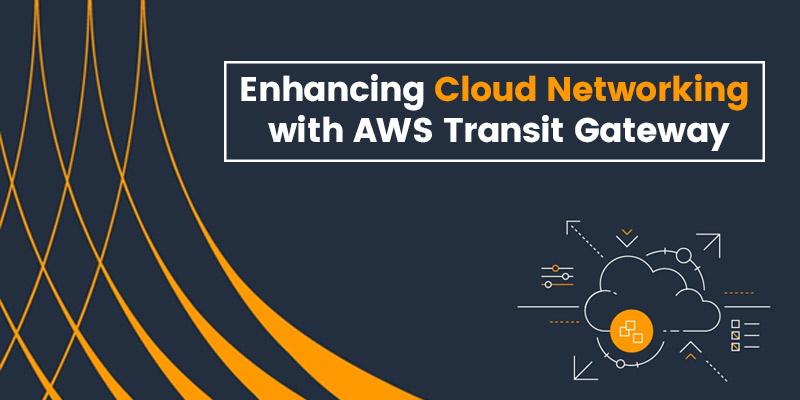
Cloud networking is the IT infrastructure that hosts an organization's network capabilities and resources on a public or private cloud platform. This infrastructure can be handled internally or by a specialized service provider, allowing the company to access resources on demand. AWS Transit Gateway is a network service that uses a hub-and-spoke design to connect on-premises data centers to Amazon Virtual Private Clouds (VPCs), all of which are united under a single gateway. So, in this blog, we'll look at what is a transit gateway in AWS, its function in improving Cloud Networking, Transit Gateway Network Manager, and other topics. You may also learn about Cloud Computing by enrolling in FITA Academy's Cloud Computing Courses in Chennai.
AWS Transit Gateway
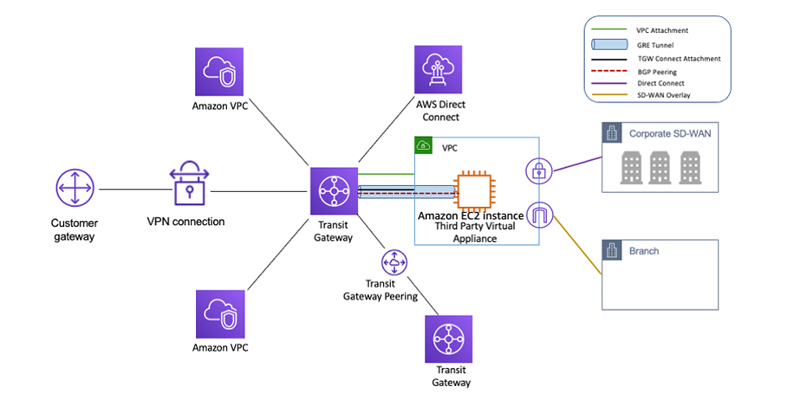
AWS Transit Gateway is a robust solution that enables effortless communication between your Amazon VPCs and on-premises networks. AWS Transit Gateway serves as a scalable cloud route, delivering considerable advantages in terms of manageability and efficiency by simplifying network design and reducing the complications of elaborate peering arrangements. Each new link is only made once. When extending your business internationally, it enables inter-region peering capabilities over the secure AWS global network. Your information is automatically encrypted and is never sent over a public internet connection. This allows you to link AWS Transit Gateways across regions for dependable, high-performance connectivity.
Role of AWS Transit Gateway in the Enhancement of Cloud Networking
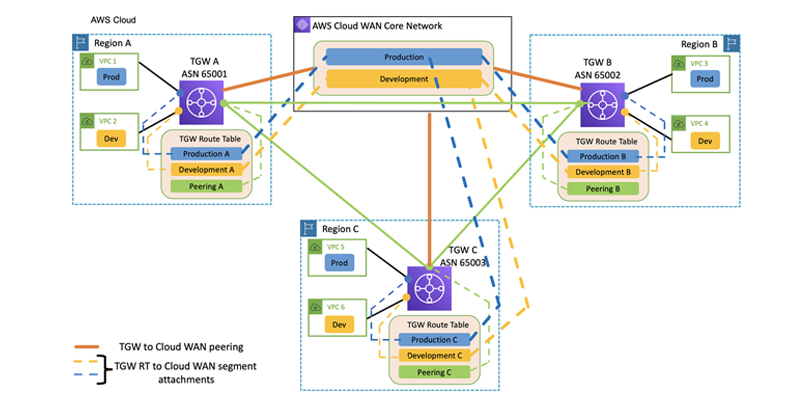
- Simplified Network Architecture: AWS Transit Gateway simplifies network architecture as a single entry point for connecting multiple VPCs and on-premises networks. It eliminates the need for complex VPC peering connections, reduces administrative overhead, and provides a scalable solution for managing network connectivity.
- Scalable and Global Connectivity: With aws transit gateway, organizations can easily scale their network infrastructure globally. It allows for inter-region peering, enabling communication between VPCs across different AWS Regions. This provides a unified network experience and facilitates the deployment of global applications.
- Improved Network Performance: AWS Transit Gateway optimizes network performance by providing high-bandwidth and low-latency connections between VPCs and on-premises networks. It supports efficient traffic routing and enables organizations to leverage AWS Direct Connect for dedicated and reliable network connectivity.
- Enhanced Security and Compliance: AWS Transit Gateway helps enforce security and compliance requirements by centralizing network policies and access controls. AWS Transit Gateway empowers organizations to enforce uniform security measures across multiple VPCs, facilitate network segmentation, and seamlessly integrate with AWS Identity and Access Management (IAM) to enable precise control over access permissions.
- Simplified Network Monitoring and Troubleshooting: AWS Transit Gateway integrates with various monitoring and logging services, such as CloudWatch, Transit Gateway Flow Logs, and VPC Flow Logs, to provide enhanced visibility into network traffic, performance, and security. This enables proactive monitoring, troubleshooting, and detection of network issues. Learn fundamental concepts of Cloud Computing by enrolling in the Cloud Computing Online Course and gain extensive knowledge of its various applications and functionalities.
Benefits of using AWS Transit Gateway in Cloud Networking
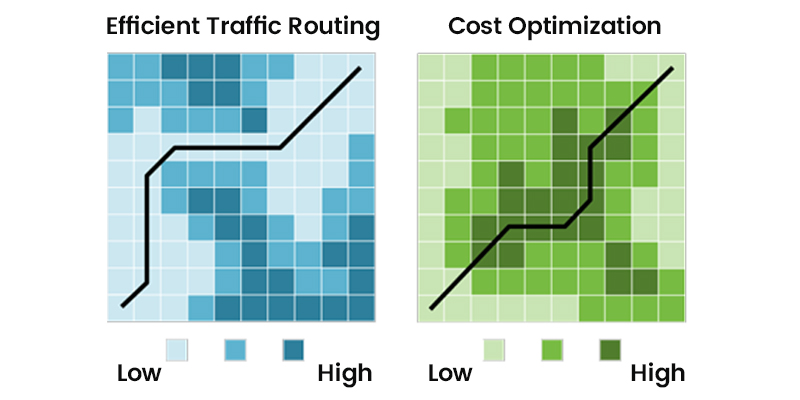
- Efficient Traffic Routing: AWS Transit Gateway offers advanced routing capabilities, enabling organizations to route traffic between VPCs, on-premises networks, and other AWS resources efficiently. It supports dynamic and static routing, allowing for flexible network configurations and optimal traffic flow.
- Cost Optimization: AWS Transit Gateway helps optimize costs by reducing the need for complex and expensive networking solutions. It eliminates the requirement for multiple VPN connections, simplifies network management, and enables organizations to leverage cost-effective connectivity options like AWS Direct Connect.
Transit Gateway Pricing
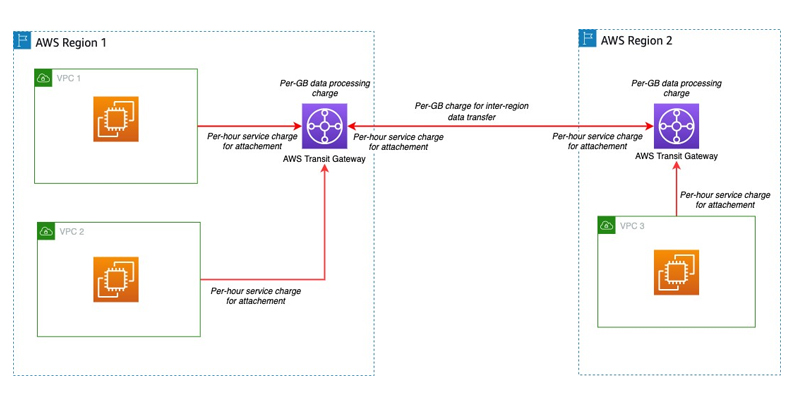
The cost structure associated with using the AWS Transit Gateway services is known as Transit Gateway Pricing. It's important to note that AWS Transit Gateway pricing can vary based on the specific region and data transfer volume. Detailed and up-to-date pricing information can be found on the official AWS website or by consulting AWS documentation. The pricing for AWS Transit Gateway is commonly based on the following factors:
- Transit Gateway Hourly Cost: AWS transit gateway pricing is based on the size and utilization of the provisioned Transit Gateway. The cost is calculated hourly, considering factors such as the number of attachments (connections) and the required level of throughput.
- Data Transfer Charges: AWS Transit Gateway experiences data transfer charges for the traffic passing through it. In this, both inbound and outbound data transfer between connected networks are involved, including VPCs and on-premises networks.
- Inter-Region Data Transfer: If you deploy Transit Gateway in a multi-region configuration and transfer data between regions, there may be additional costs for inter-region data transfer. These charges are implemented to account for the bandwidth and resources utilized for data transfer over the Transit Gateway infrastructure.
Additional uses of AWS Transit Gateway in Cloud Networking
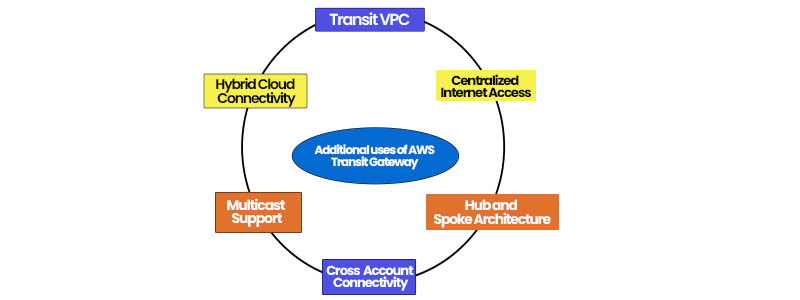
- Centralized Internet Access: AWS Transit Gateway can centralize internet access for multiple VPCs. Attaching a transit gateway to a virtual private gateway allows you to route internet-bound traffic from multiple VPCs through a common set of network appliances or services, simplifying network management and enhancing security.
- Hub and Spoke Architecture: AWS Transit Gateway facilitates the implementation of a hub and spoke architecture. By connecting multiple VPCs to a transit gateway, you can establish a central VPC as the hub, enabling secure communication between the hub and spoke VPCs. This simplifies network design, reduces complexity, and improves network performance.
- Cross-Account Connectivity:aws transit gateway supports cross-account connectivity, allowing organizations to connect VPCs belonging to different AWS accounts. This enables secure communication and resource sharing across multiple accounts while maintaining network isolation and control.
- Multicast Support: AWS Transit Gateway provides multicast support, allowing organizations to host multicast applications in the cloud. This eliminates the need for specialized multicast hardware and simplifies the deployment and scaling of multicast applications based on demand.
- Hybrid Cloud Connectivity: AWS Transit Gateway enables seamless connectivity between on-premises networks and Amazon VPCs. Organizations can extend their network resources into the cloud by establishing VPN connections or leveraging AWS Direct Connect, facilitating hybrid cloud architectures and enabling hybrid cloud deployments.
- Transit VPC: AWS Transit Gateway can serve as a central transit VPC, providing connectivity between multiple VPCs and on-premises networks. This allows organizations to consolidate network traffic and apply consistent network policies, security controls, and auditing mechanisms across their infrastructure. To see how Cloud Computing might be used, join the Cloud Computing Courses in Bangalore and learn the various applications and their functionalities.
Benefits of Transit Gateway
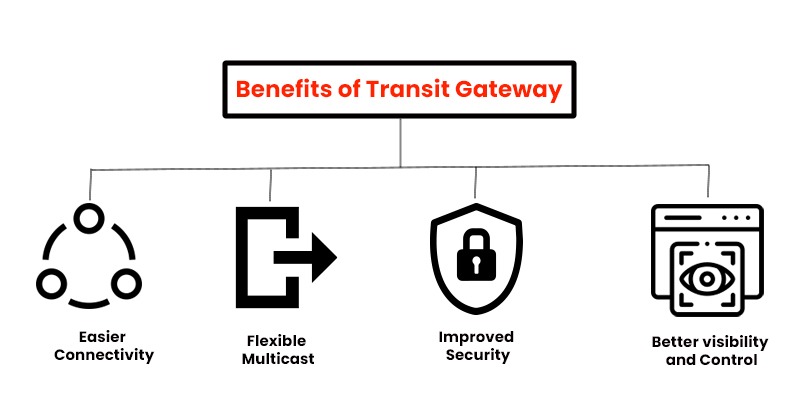
- Easier connectivity: Simplify network connectivity with Network Manager as a cloud router. Managing incremental connections becomes a breeze as your network expands without compromising performance. Effortlessly connect AWS transit gateway through inter-Region peering, enabling the creation of global applications. Network Manager empowers you to design and manage your network easily, eliminating connectivity's complexity and ensuring smooth operations. Stay ahead of network growth and effortlessly maintain a scalable infrastructure with Network Manager as your reliable partner.
- Flexible multicast: Experience the flexibility of multicast with AWS Transit Gateway multicast support. This feature helps distribute the same content to multiple destinations, eliminating the need for expensive on-premises multicast networks. Benefit from reduced bandwidth requirements for high-throughput applications such as video conferencing, media streaming, and teleconferencing. With AWS Transit Gateway multicast, you can enhance network resources while seamlessly delivering content to specific destinations. Say goodbye to complexity and embrace multicast efficiency with AWS Transit Gateway.
- Improved security: Experience enhanced security with aws transit gateway, leveraging the robust AWS global private network. The network effectively routes traffic between your Amazon Virtual Private Cloud (VPC) and AWS Transit Gateway, ensuring it is not accessible to the general public. Trust in the reliability and security of AWS Transit Gateway for comprehensive protection.
- Better visibility and control: Gain unparalleled visibility and control over your network with AWS Transit Gateway Network Manager. Effortlessly monitor your Amazon Virtual Private Clouds (VPCs) and edge connections. With seamless integration with popular SD-WAN devices, AWS Transit Gateway Network Manager empowers you to swiftly identify issues and respond to events across your global network. Experience the convenience of a centralized management platform that provides real-time insights and enables proactive network management. Take charge of your network with AWS Transit Gateway Network Manager and experience unmatched visibility and control.
Necessities: Transit Gateway?
- Without AWS Transit Gateway: Scale increases complexity. Within each VPC, you must maintain routing tables and connect to each onsite location using separate network gateways.
- With AWS transit gateway: Your network is more efficient and scalable. AWS Transit Gateway routes all traffic to and from each VPC or VPN, and you can manage and monitor it all from a single location.
Monitor your transit gateways
Enhance your network monitoring and troubleshooting capabilities with the following features:
- Cloud Watch Metrics: Leverage Amazon CloudWatch to access essential metrics and statistics about data points for your transit gateways. These metrics offer valuable insights into the operational performance of your system, empowering you to maintain optimal functionality and performance.
- Transit Gateway Flow Logs: Gather detailed information about network traffic on your transit gateways using Transit Gateway Flow Logs. These logs offer comprehensive visibility into the data flow, empowering you to analyze traffic patterns and identify potential issues.
- VPC Flow Logs: Gain in-depth insights into the traffic to and from VPCs connected to your transit gateways through VPC Flow Logs. Collecting detailed information about this traffic allows you to monitor and analyze network activity, enabling efficient troubleshooting and performance optimization.
- CloudTrail Logs: Utilize AWS CloudTrail to gather detailed logs of transit gateway API calls. These logs, stored in Amazon S3, provide comprehensive information about the calls made, including the source IP address, the user initiating the call, and the timing of the call. This data is invaluable for auditing, security analysis, and tracking changes in your network.
Uses of Transit Gateway
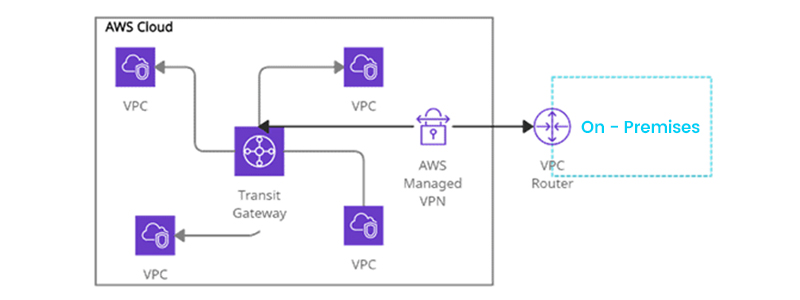
- Experience global application delivery: AWS transit gateway allows you to create applications that span thousands of Amazon VPCs. This means you can deploy new applications without the hassle of updating extensive route tables for peering relationships. Simplify installation, management, and troubleshooting for a streamlined experience.
- Effortlessly scale to a global level: With AWS Transit Gateway, everything connected to it is shared across AWS Regions through inter-region peering. This includes VPCs, DNS, Microsoft Active Directory, and IPS/IDS. Expand your infrastructure rapidly and efficiently to meet global demands without complex connections or massive routing tables.
- Respond smoothly to spikes in demand: Address unforeseen demand by quickly adding Amazon VPCs, AWS accounts, VPN capacity, or AWS Direct Connect gateways. AWS Transit Gateway enables you to scale your network infrastructure without dealing with intricate connections or extensive routing tables.
- Host multicast applications in the cloud: Leverage the multicast feature of AWS Transit Gateway to host multicast applications without modifying your application or on-premises network. Scale your multicast applications dynamically based on demand, eliminating the necessity of investing in and managing specialized hardware for peak application loads.
AWS Transit Gateway provides a powerful solution for enhancing cloud networking capabilities. It simplifies the management and connectivity of thousands of Amazon VPCs, allowing for application deployment without the complexities of updating extensive routing tables. We explored what is aws transit gateway, its uses, benefits, and so on. Want to learn Cloud Computing from the basics? Join Cloud Computing Training in Coimbatore at FITA Academy and start learning Cloud Computing from the basics.
